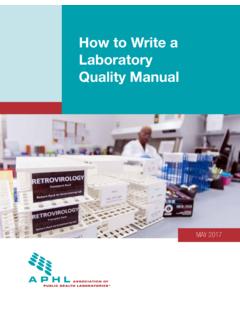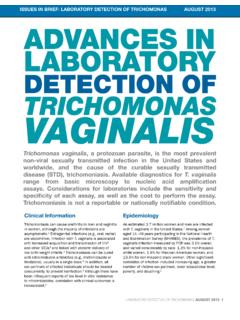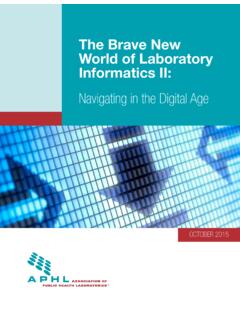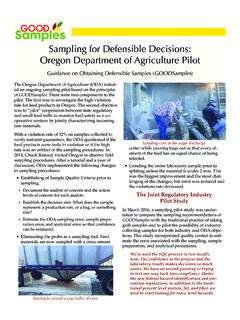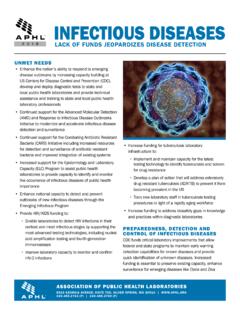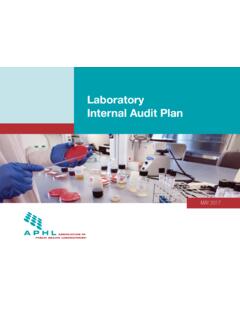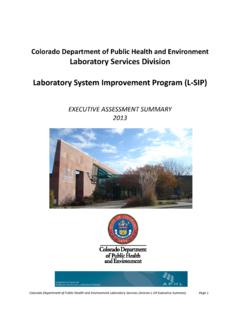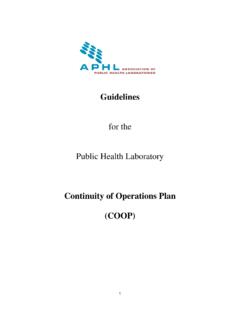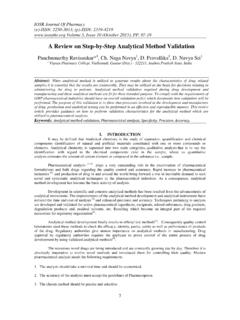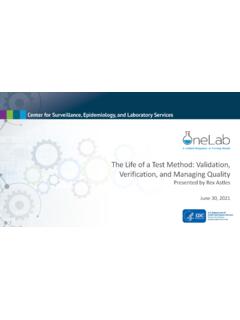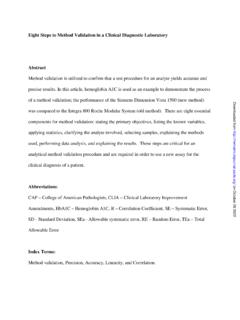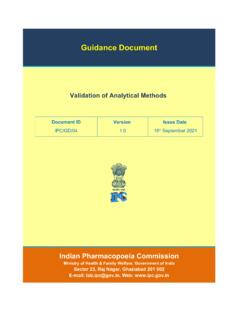Transcription of CLIA-Compliant Analytical Method Validation Plan and ...
1 LRN-C Analytical Method Validation PLAN & TEMPLATE 20131 TABLE OF CONTENTS List of LRN Clients and Requirements for Analytical Method Performance Method Performance Specifications and Validation Analytical Method Validation Plan and TemplateFOR LRN-C LABORATORIESISSUES IN BRIEF: LRN-C Analytical Method Validation PLAN & TEMPLATE DECEMBER 2013 LIST OF ACRONYMSEQA External Quality AssessmentHPLC-MS/MS High-Performance Liquid Chromatography Tandem Mass SpectrometryIS Internal StandardLDT Laboratory Developed Test(s)LOD Limit of DetectionLOQ Limit of QuantitationPK/PD Pharmacokinetic/Pharmacodynamic modelingTEa Total Allowable ErrorULOL Upper Limit of Linearity APHL PUBLIC HEALTH LABORATORIES2 INTRODUCTION The Laboratory Response Networki (LRN)
2 And its partners maintain an integrated national and international network of laboratories that can respond quickly to acts of chemical, radiological or biological terrorism, emerging infectious diseases and other public health threats and The Laboratory Response Network for Chemical Threatsii (LRN-C), representing over 40 public health laboratories, remains dedicated to the establishment and preparedness of Analytical toxicology services that meet needs for emergency response, investigation and patient care. The Clinical Laboratory Improvement Amendmentsiii (CLIA) applies to LRN-C clinical tests (tests on human blood, urine or other tissue) as do LRN Network requirements.
3 These dual requirements include Method Validation procedures. The Association of Public Health Laboratoriesiv assembled a Taskforce tasked with providing a guidance document to assist LRN-C laboratories in meeting these requirements. This document is provided for general guidance purposes only. Individual laboratories and laboratory directors remain responsible for meeting all CLIA 88 clinical laboratory regulations (42 CFR 493)2 and may have specific needs not addressed by this document. Modifications may be required to meet all applicable federal regulations. LRN CLIENTS AND RESPONSIBILITIESAn understanding of the needs and expectations of potential clients in emergency preparedness and response is essential to establishing minimum requirements for CLIA-Compliant performance specifications, policies and regard to potential clients, the LRN-C provides Analytical and investigative support to public health officials, epidemiologists, toxicologists, healthcare providers, law enforcement, environmental health and food safety specialists, and poison control centers.
4 LRN-C helps determine the cause and origin of a public health incident and to definitively characterize the organism or agent responsible. National Standards for Public Health Preparedness at the State and Local Levelv include the ability to perform the following: Function 1: Manage laboratory activities Function 2: Perform sample management Function 3: Conduct testing and analysis for routine and surge capacity Function 4: Support public health investigations Function 5: Report resultsQUALITY REQUIREMENTS FOR Analytical SERVICESA quality management system must be in place to ensure the delivery of timely and reliable services. The recommendations put forth in this document address only the establishment of performance specifications for Analytical methods and the Validation of Method performance characteristics.
5 The laboratory is responsible for good laboratory practices and compliance with1 APHL. Laboratory Response Network. , accessed May Centers for Medicare and Medicaid Services, HHS. Standards and Certifications: Laboratory Requirements. Part 493. Analytical Method Validation PLAN & TEMPLATE 20133regulatory program requirements for all phases of laboratory LRN-C uses laboratory-developed tests (LDTs) to analyze clinical specimens for toxic substances identified as possessing high risk and consequence to the public health. CLIA 88 rules require the laboratory to establish performance specifications and to validate Method performance for the following Method characteristics: accuracy precision (within run, between run, between day) reportable range Analytical sensitivity and specificity reference intervals CLIA rules and guidance3 are silent on minimum requirements for Validation protocols; however, Validation plans, experiments, results and conclusions are rigorously reviewed for scientific merit and integrity.
6 The laboratory director is responsible for establishing individual laboratory criteria. The Validation plan and template provided in this document: guides the laboratory director in the establishment of Method performance specifications considering the intended use of the Analytical findings meets or exceeds minimum regulatory and accreditation program requirements for LDT Validation Analytical Method PERFORMANCE SPECIFICATIONSA. Accuracy and Precision4,5 The following is a hierarchy of recommended approaches to the establishment of requirements for the accuracy and precision of clinical Analytical Medical usefulness requirements based on the effect of Analytical performance on clinical decisions such as:a.
7 Toxicological and pharmacological informationb. Clinicians opinions related to specific cases2. Published professional recommendations from:a. National and international expert bodies and agenciesb. Expert local groups or individuals3. Performance goals set by:a. Regulatory bodies and agenciesb. Organizers of External Quality Assessment (EQA) schemes4. Goals based on the current state of the art, which include:a. Inter-laboratory comparison programs 3 See CLIA Interpretive Guidelines for Laboratories, Appendix C The hierarchy is based on the consensus agreement published in the Scandinavian Journal of Clinical and Laboratory Investigation 1999; 59: 585.
8 5 Note: When available and appropriate, models higher in the list are preferred to those lower in the list. However, based on requirements needed to maintain accreditation, proficiency testing requirements define the minimum standards for performance. While proficiency testing may be appropriate for some tests, medical usefulness requirements are usually more stringent and may be PUBLIC HEALTH LABORATORIES4b. EQA or proficiency testing schemesc. Current published information on methodologyAnalytic goal setting for the quantification of drugs for medical usefulness requirements typically requires estimates of biological variation (pharmacokinetics) and drug concentration thresholds that guide clinical management.
9 The rarity of human exposure to most of the agents tested by the LRN-C, and the analysis of urine for metabolites compromise the ability to collect the necessary pharmacokinetic/pharmacodynamic modeling (PK/PD) information needed to establish objective medical requirements for Method performance. Published professional recommendations for the accuracy and precision of Analytical toxicology methods with intended use comparable to that of the LRN-C are available from the Scientific Working Group for Forensic Toxicology, the Food and Drug Administration, the National Laboratory Certification Program and the Clinical and Laboratory Standards goals set by CDC (in the Public Health Emergency Preparedness cooperative agreement) clearly establish minimum quality requirements for Analytical methods.
10 LRN-C Level 1 and 2 laboratories must attain and maintain qualified status, ( , the laboratory must meet reference materials characterization requirements and perform successfully in scheduled PT exercises).Based on the criteria described above, total allowable error (TEa), incorporating evaluation of both accuracy and precision, should not exceed 25% for LRN test methods. The TEa is the maximum error that can be tolerated under terms of the intended use of test Reportable Range The reportable (or Analytical measurement) range is established in each Analytical run, through analysis of a full range, multi-point calibration The process of confirming that the assay system will accurately determine the concentration of the analyte over the reportable range includes the reprocessing of each calibrator as a sample against the calibration curve.
